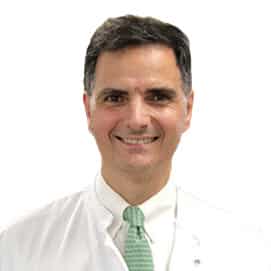The German Low Grade Non-Hodgkin's Lymphoma Research Group (GLSG) has been conducting research on the treatment of indolent lymphomas (follicular, lymphoplasmacytic and nodal marginal zone lymphomas) and aggressive mantle cell lymphomas since 1988.
Research has contributed to the acceptance of new treatment concepts (interferon maintenance therapy, high-dose therapy, combined immunochemotherapy) around the world.
Indolent (low grade) non-Hodgkin's lymphomas (NHL) often for many years proceed non-aggressively. Some patients suffer more from the side effects of chemotherapy than from the underlying disease itself. In addition, chemotherapy is less effective for indolent lymphomas, as slowly dividing cells are also less susceptible to cytotoxic drugs. Accordingly, chemotherapy is used only when symptoms or complications of NHL are observed.
In contrast to aggressive NHL, in indolent forms, radiation therapy in the early stages plays a major role in the treatment concept. In stages I and II, indolent lymphomas often respond to radiation therapy. At later stages, chemotherapy and (or) radiation can temporarily (such periods can be long) to stabilize the course of the disease.
Indolent non-Hodgkin's lymphomas in stage I or II
Indolent lymphomas in stages I or II often respond to radiation therapy. Areas of affected and adjacent lymph nodes (expanded field therapy) or all regional lymph nodes of the body (“total irradiation”) are exposed to irradiation.
Treatment options:
- Irradiation of the region in which tumor cells were found
- Irradiation of the region in which tumor cells were found, as well as irradiation of lymph nodes located nearby
- Irradiation of most or all of the lymphatic system
- Studies are underway to combine radiation with chemotherapy.
- Only chemotherapy with watchful waiting with close monitoring if radiation cannot be delivered
Indolent non-Hodgkin's lymphomas in stage III or IV
In later stages, indolent non-Hodgkin's lymphomas are often not cured. The goal of treatment is to slow down the course of the disease, eliminate symptoms, and prevent complications (palliative care). As a rule, this therapy is initiated only when the disease progresses rapidly or when aggravating symptoms occur, and the primary therapy consists of chemotherapy to reduce the mass of the tumor.
Treatment options:
- Waiting attitude with close observation until symptoms occur
- Chemotherapy with one or more cytotoxic drugs
- Chemotherapy in combination with immunotherapy (currently only available in clinical trials)
- Chemotherapy plus bone marrow transplantation or peripheral stem cell transplantation (autogenous/allogeneic, currently only available in clinical trials)
- Radioimmunochemotherapy with or without chemotherapy (currently available only in clinical trials).
The efficacy of high-dose chemotherapy combined with whole body irradiation and autologous stem cell transplantation in younger patients (under 60 years of age) with the disease is currently being studied.
With additional "maintenance therapy", such as interferon-alpha, it is possible to slow the recurrence of the disease. The use of the monoclonal antibody rituximab for maintenance therapy is currently being studied.
Recurrent indolent non-Hodgkin's lymphomas
Indolent lymphomas often reappear after successful treatment. Sometimes the disease recurs as a different cell type lymphoma (with a different histology), often as an aggressive lymphoma. If the recurrence is again low-grade lymphoma, further actions are guided by the treatment plan in stages III and IV.
Treatment of low-grade non-Hodgkin's lymphomas, the cells of which have a certain sign on the surface (CD20 antigen), in case of recurrence, can be carried out with the monoclonal antibody rituximab, which causes tumor shrinkage in some patients.
plasmacytoma
A special place is occupied by the so-called plasmacytomas. This is a malignant reproduction of plasma cells, which form numerous nests, mainly in the bones, and violate their stability. Along with the resulting bone fractures, due to the penetration of the tumor into the bone marrow, as in leukemia, it can also be noted the suppression of all three hematopoietic sprouts, an increase in the level of calcium in the blood and, due to the accumulation of pathological protein in the blood, lead to acute kidney failure and other life-threatening complications. Although the individual course of the disease varies greatly from each other, plasmacytoma in the absence of treatment in most cases progresses very quickly. But it is advisable to start treatment only at a certain stage of the disease. It may be chemotherapy, radiation therapy, or a combination of the two. Currently, a cure for plasmacytomas (with the rare exception of solitary plasmacytomas) is not possible. In clinical trials, high-dose chemotherapy with autologous stem cell transplantation for patients under 70 years of age in good general condition is currently the standard of care. Also in clinical trials, patients at a young age in good general condition undergo high-dose therapy with autologous stem cell transplantation. Because of the risks, these treatments, which in the best cases can prolong the stable phase of the disease for many years, are only allowed in clinical trials.
Skin lymphomas
Low-grade non-Hodgkin's lymphomas may initially involve only the skin (cutaneous lymphomas). The most common malignant lymphoma of the skin is the fungoid granuloma. As long as its prevalence is limited to the skin, these lymphomas respond well to treatment, which can be treated with cytotoxic drugs (drugs that prevent cell division), steroids, or preparations of the acid form of vitamin A (retinoids) exclusively for external (topical) use. Often carried out photochemotherapy: after the introduction (psoralen), which make the cells of the body light-receptive, the entire skin is exposed to UV rays.
In later stages, when the lesion also extends to organs in addition to the skin, systemic chemotherapy with cytotoxic drugs is considered, as well as the introduction of interferon-alpha or cortisone preparations.
MALT-lymphomas
Mucosal lymphomas are primarily found in the stomach. They are often caused by chronic inflammatory pathogens, such as infection with the bacterium Helicobacter pylori. In this case, the infection is first treated with antibiotics and gastric acid inhibitors. In the early stages, this also leads to the reverse development of lymphoma.
If the tumor persists, the disease has already progressed, or it is a high-grade lymphoma, it is necessary to make a choice in favor of intensive therapy, therefore, chemotherapy with local radiation is performed.
Head of the Clinic of Oncology, Hematology and Palliative Medicine
Video
Request appointment
Useful links
Photo gallery








